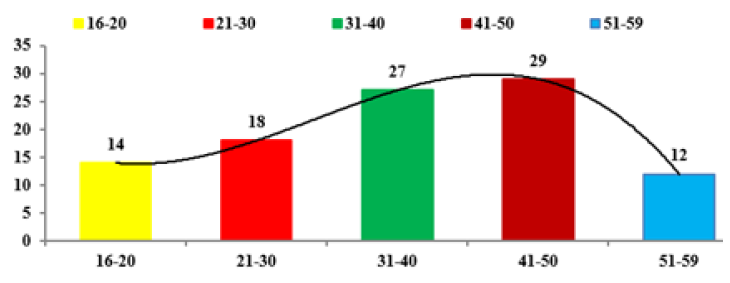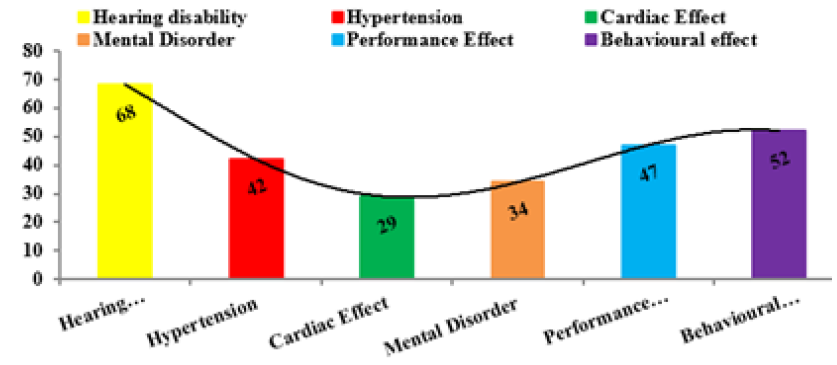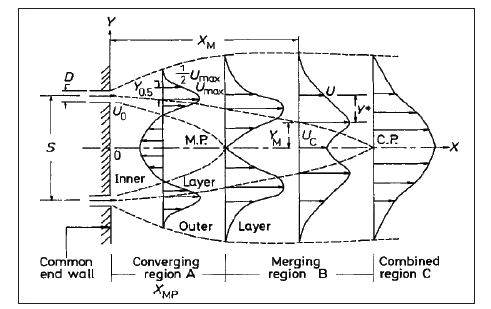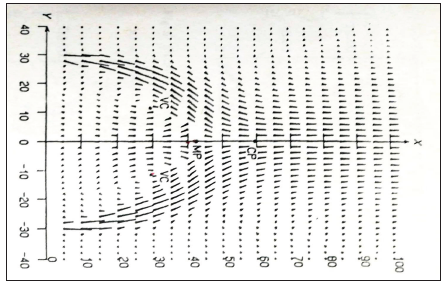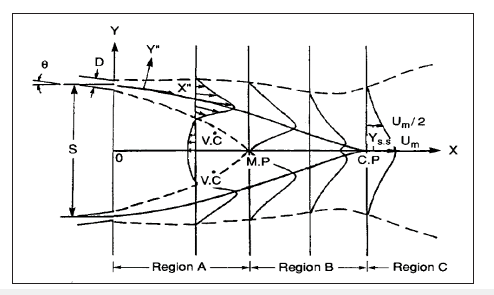Intercultural Communication Problems of Nigerian
Students in Mainland China by Dorathy Onyinye
Achu in Archaeology & Anthropology:Open Access_journal of archaeological science abbreviation
Abstract
The advancement of globalization and development of the Sino-African framework has increased
migration of Nigerian students in search of foreign education to China. On arrival, these students are faced
with very many challenges and difficulties. Cultural differences and personal adjustment problems has
affected the Nigerian students language acquisition and adjustment patterns, creating an urgent need to
proffer Solution to this inter cultural communication problems. This research focuses on the intercultural
communication competence of Nigerian students studying at various Universities in China and explores
through literature and practical research; the reason behind their lack of smooth integration within
the Chinese society, the frequency of interactions with the Chinese nationals, difficulties encountered,
reasons attributed to these difficulties, and the different coping method employed.
The investigative Results reveals that majority of the Nigerian students have no prior socio-cultural
knowledge of the host country, and have problems in their Social, education cultural and personal
adaptation patterns, which they attribute to lack of intercultural communication knowledge, culture
shock, ethnocentrism, racial discrimination, differences in nonverbal communication between countries.
Findings suggests the following; an Expansion & Restructuring of the Confucius Institute in Nigeria to
fit the growing Chinese language population in Nigerian, need for an extensive theoretical and practical
Chinese cultural studies through organization of inter and extra-curricular activities, introduction of a
multi-cultural curriculum, embedment of the intercultural studies into the language curriculum, and
most importantly is for orientation programs to be organized by the embassy prior to students departure.
Keywords: China; Cultural adaptation; Globalization; Intercultural communication; Nigerian students
Abbreviations: BRICS: Brazil, Russia, India, China and South Africa; GDP: Gross Domestic Product; PRC:
People’s Republic of China; CSC: China Scholarship Council
Introduction
Studying in a multicultural environment has turn out to be overwhelmingly popular
globally. For decades, it has been a popular method of exposing students to international
perspectives [1,2]. This is because; students attending university overseas have the
opportunity to discover novel cultures and environments [3] and to reflect on their own
culture’s shortcoming [4]. Based on the fact that communicating with others that come from
different cultures is an invaluable skill for any international student [5]. In the decades since
1950, political, social, and technological barriers have been diminished by globalizing forces
that are fueling the economies of high-growth nations such as Brazil, Russia, India, China and
South Africa (commonly referred to as BRICS), leading to an international convergence in
economies and narrowing the asymmetries between developed and developing nations [6].
Education and cultural communication are a formidable pivot in that convergence, which
has been further accentuated by the worldwide flows of students and by the pervasive
dissemination of core knowledge, which Badaracco [7] delineates as migratory and embedded.
Such flows have major implications for the well-being and competency of participants on the
worldwide landscape, especially those in the University [8,9]. This is because the cultural
difference comes with diverse responsibility, and sometimes it feels like one is struggling
alone. Imagine leaving a familiar terrain to go into an unfamiliar territory where everything
ranging from language, culture, food and so on, seems different and you are struggling so hard
to understand how things operate. It is like taking a giant leap into the unknown. Globally,
cultures have their own values, individual traditions, beliefs and norms, which can surely
make them unique from each other. As a result of diverse culture and community practices,
the sojourners always face culture shock when they first get to the host nations.
Speaking of host nation, recently China has been a hub for a
vast majority of International students. Having come a long way
since it became the People’s Republic in 1949, and as an emerging
nation, with a record two-digit growth rate of the Gross Domestic
Product (GDP) every year until 2014, its association in the group of
emerging newly industrialized and developing economies (BRICS),
has made it a world leader in the economic front. China is Africa’s
biggest economic partner, followed by France and the US. Besides
its commercial and economic involvements, education is also a
great component of the Sino-African Framework. Twenty years
ago, a political scientist named Gerard Segal wrongfully predicted
that Africa would be “the least important region for China” [10]. As
of 2009, China has surpassed the United States as African’s largest
trade partner [11]. The linkage between Africa and China goes
back to the 10th century, although the media and international civil
society have only become aware of Sino-African relations this past
decade. China has made significant improvement in the aspect of
offering scholarship to African students. Currently China is coming
up on the list of preferred places Nigerian students or African
students in general prefer to study. Since 1960, France has been the
major hub of the African student body, and this comes mainly from
former French colonies. England, which has a majority of Nigerians
and Kenyans, is a major destination for the English colonies, while
Portugal is the main destination country for Mozambicans, Cape
Verdeans and Angolans. Spain is the main destination country
for Equatorial Guineans. Hence it could be calculated as the first
destination for Sub-Saharan Africa, is Western Europe: France
(21%), United Kingdom (12%), Germany (6%) and Portugal (5%). In
2000 China announced, among others, the creation of the Confucius
institutes; cultural and linguistic centers in Africa, and a doubling
of study grants for Africans, principally in the areas of medicine,
agriculture, languages, education, economics and management.
In 2009, 49 African countries adopted an action plan for 2010-
2012 with China, this intensified both University and Scientific
cooperation, and increased Chinese government grants to 5,500
African students in 2012, and 100 joint research and development
projects to promote Chinese language in Africa. The action plan that
was signed in 2012, against 2013-2015, was meant to provide for
18,000 student grants and development of the Confucius institutes
(University world News Report 2013). Currently China’s intent is
to offer 50,000 government scholarships to African students, invite
200 African scholars to annual visit, offer 500 young Africans study
trip to China, and provide 2,000 educational opportunities with
degrees and diplomas [12]. These figures are quite impressive
considering, the increase in scholarship for African countries from
2011 till now.
Some sources quoted the numbers of African students on
Chinese scholarship were from 922 in 1996 to 7821 in 2014 [13,14].
Based on the paradigm switch in bilateral relations as well as the
growing economic importance of Nigeria, as can be seen in mid-
2016, it overtook South Africa as the largest economy on the African
continent and is recently viewed as having the potential to emerge
as a major global economy. However, a substantial dependency on
oil revenues has radically undercut this potential. Just as there has
been a marked increase in the total influx of foreign students into
China, so has there been an increase in the number of Nigerian
students in China. Nigeria is one of the developing countries with
higher priority on education and many Nigerian students can now
access their preferred fully funded higher education programs and
Chinese language programs in China. As such, every year numerous
Nigerian students enroll in Chinese universities, and the number
keeps soaring. As a result, in the twenty-first century Chinese
educators are finding their classrooms filled with students from
diverse cultures. This increase in Nigerian students studying in
China is as a result of the establishment of the Forum on China-
Africa Cooperation that was established in 2000.
The forum was encouraged in part by the burgeoning, diverse
relationships between the People’s Republic of China (PRC) and
Africa, which continues to send many its students to China. And the
soaring figures of Nigerian students in China provide a beachhead
for including Nigerian youth in the development of Nigeria and
the building of a stronger relationship between Nigeria and
China. Additionally, it is plausible that China’s interest in sharing
its culture and language with the Nigerian youth, enrolled via the
China Scholarship Council (CSC), is that China trained Nigerians
may in the long run serve as volunteer ambassadors of Chinese
culture. While this idea and studying in China may sound so
exciting the cultural differences among students have a significant
impact on the learning, communication process, and understanding
between Chinese and Nigerian students. Speaking of cultural shock,
in a psychological MA thesis based on an investigation of 181
feedbacks out of 210 forms, a rather high ratio for an investigation.
The author aim of the study was to examine cultural shock and
adaptation among African students in China. It found that cultural
shock is common for African students in China, and the best remedy
is to increase social contact with local people. It also found that
although all African students experienced cultural shock, the extent
is different according to the grade and gender, e.g., more serious for
undergraduates than graduates, female than male [15-18]. Other
studies are either on cultural adaptation, cultural differences and
their impact, or different concepts of time and family. In order to
solve this culture shock, Anderson [19] asserts that students need
guidance when identifying diverse cultural traditions. A brief study
of the Nigerian, Chinese Culture, people and their behavioral pattern,
will give an insight to why these students face such Challenges in
China, and how to quickly adapt to the new environment.
Methodology
The descriptive survey design is chosen for this research, while
a quantitative and qualitative research approach was employed.
A sample size of two hundred and fifteen people (215) was used
to represent all Nigerian students in China, and 10 people were
randomly selected for interviews. Instruments for data collection
include Observation, questionnaire and interview. For this study,
two instruments for data collection were used; questionnaire and
interview. The questions were all close ended questions and consist
of two sections. It was designed this way to make analysis simple
and less complicated. The first section is from question 1-25 and
comprise of both the single and multiple, choice questions, while
the second section consist of 25 questions ranging on a scale of 5
(Not difficult, slightly difficult, comparatively difficult, Difficult,
very difficult). The Interview was carried out by direct contact and
through telephone.
A Purposive sampling was chosen as the best fit for this
research, as participant need to
a. Be a citizen of Nigeria.
b. Be studying in any University in China.
c. Be a registered Chinese Language Program/Bachelor
degree/Master degree student.
d. Be willing to co-operate and partake in the research.
Anonymity and Confidentiality was key in the course of
the research. Student’s anonymity was promised and ensured
during the course of this research, this led to their turnout and
appropriateness in filling the survey.
Findings
Respondent’s demographic profile
From the data obtained, male respondent were, one hundred
and twenty-nine (129), females were eighty-six (86), which is
sixty percent 60% and forty percent 40% respectively. This gives
a total of 215 respondents. The gender of respondent is indicated
in the A pie chart below (Figure 1). The age of students were also
taking into consideration. It was observed that from age 18-24 had
a majority of one hundred and five people (105) making up 48.84%
of the population, while 25-29 age range was the second highest,
with a total number of 70 people making up 32.56%, while 30-35
age range had 27 people making up 12.56%. Student less than 18
years of age and greater than 35 years of age had the least number
with a total of 6 and 7people respectively, making up 2.79 and 3.26
respectively in the B pie chart. The C above shows the number of
years spent in China. It was observed that majority of the student
(90 people) have spent 1-2 years in China, making up 41.86%
while 58 people have lived lesser than 1 year in China, making up
26.98%. There is a downward trend after having lived for 2 years,
it is observed that the higher the years, the lesser the number of
Nigerian students, as 57 people have stayed 3-5 years, making up
26.51%, and only 10 persons has stayed over 6 years- 4.65%.
Figure 1:Distribution (%) of gender, age, and duration of stay in China..
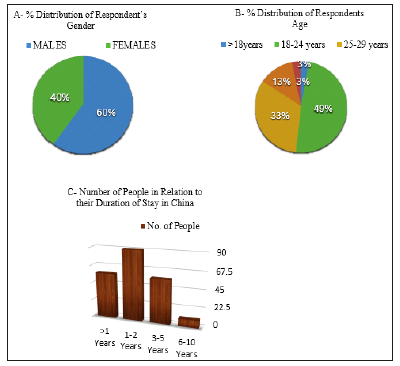
Respondent’s language proficiency
The first objective of this study is to find out the Cultural
communicative Problems of the Nigerian student in China. In view
of this, the following questions were asked to elicit information on
their Chinese language ability (Figure 2). Chart D gives the duration
of Chinese language study. 51 people (23.72%) have studied for
less than a year, while 90 people (41.86%) have studied between
1-2 years, while 68 people (31.63%) have studied the language
between 3-5years, and just 6 people (2.79%) have studied between
6-10 years.
It was important to note if the Nigerian students had prior
knowledge of Chinese language before coming to China. The result
from E states clearly that 120 people (55.81%) representing
majority of the Nigerian students had no prior Knowledge of the
Chinese language, while 95 people (44.19%) had a basic knowledge
of Chinese language. When asked if Age has a correlation with their
Chinese ability, since majority of the Nigerian students in China are
teenagers in their youthful stage. It’s interesting to note that 57
students (26.51%) agreed that their age influences their language
learning while 158 students (73.49%) said age has no correlation
with their language ability. G shows 130 students (60.47%) do
not believe that their language ability diminishes with age, while
85 students (39.53) believe and agreed that their language ability
diminishes with age.
Nigerian students adjustment problems
In Chart H Students were asked if they had communication
problems with the Chinese. 156 (72.56%) Students responded
yes, while 59 students (27.44%) said they didn’t have a problem of
communication with the Chinese (Figure 3). In-order to understand
their communication problems, its important to understand the
language area they find problematic, frequency at which they use
the Chinese language, Ease at which they communicate with the
Chinese nationals, and their interaction pattern. 113 students
(52.56%) reportedly found writing characters to be the hardest and
most difficult, followed by Grammar which 58students (26.98%)
also found to be difficult as it affects both their orals and writing. 22
students (10.23%) indicated orals while 22 other students found
listening to be their major problem.
Figure 2:Respondent’s duration of chinese study, prior knowledge of chinese lang., age correlation and ability
of language study to diminish with age.
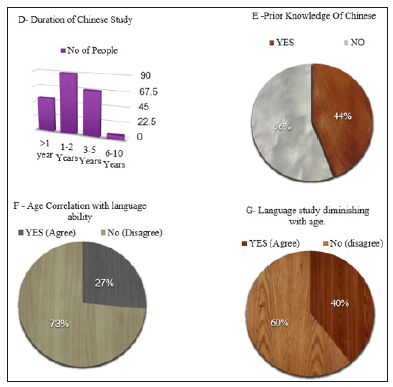
Figure 3:Distribution of students having Chinese communication problems and the various aspects of difficulties.
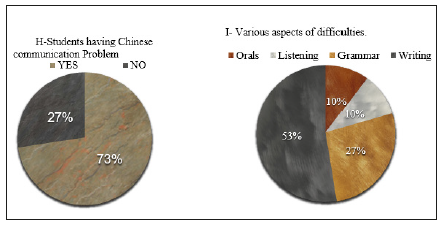
Language barriers affecting inter-cultural communication:
The chart J shows the most frequently used language Nigerian
students use in communication with co-nationals, Africans, Chinese
students and other nationals in China. 154 students (71.63%) chose
English, 41 students (19.07%) chose Chinese language, 18students
(8.37%) chose Igbo, and 2students (0.93%) chose Yoruba. Chart
K shows how many Chinese friends the Nigerian students have. It
is clear that the majorities have Chinese friends, but the number
of friends varies as 102 students (47.44%) have over 6 Chinese
friends, 60 students (27.91%) have 3-5 friends, 47 students (21.86)
have over 6 Chinese friends, 60 students (27.91%) have 3-5 friends,
47 students (21.86) have 1-2 friends while 6 students (2.79%) do
not have a Chinese friend.
Chart L tells us how often they spend in the company of their
Chinese friends. 23students (10.7%) hang out daily with their
Chinese counterpart, 34 students (15.81%) hang out 2-3times in a
week, 47 students (21.86%) hang out once in a week, 15 students
(6.98%) hang out every fortnight, and 96students (44.65%) only
hang out once in a month (Figure 4). Chart M tells us what kinds of
conversation are usually exchanged between the Nigerian students
and their Chinese friends. The graph below gives us a good detail
of their conversational pattern. B Language Preference and Ease of
Communication Students were asked upon arrival to China, which
group of people did they looked forward to mingling and making
friends with. 59 students (27.44%) indicated Africans, 56 students
(26.05%) looked forward to the Chinese as friends, 51 students
(23.72%) preferred Nigerians and 49 students (22.79%) looked
forward to making friends with other nationals (Figure 5). Chart
O further explains whom students found it easier communicating
with. 87students (40.47%) found it easier communicating with
their fellow Nigerians, 66 students (30.7%) found it easier
communicating with Africans, 36 students (16.74%) found it easier
communicating with other nationals, while 26 students (12.09%)
found it easier communicating with the Chinese.
Figure 4:Showing most used language, number of chinese friends, frequency of hangouts and topics discussed.
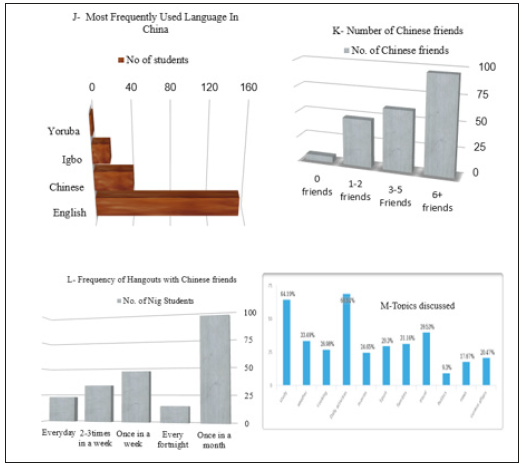
Figure 5:Showing preferred friends and their ease of communication with respect to country..

Cultural & personal barriers affecting inter-cultural
communication: P-highlights the aspect of culture that impacts the
Nigerian students’ Chinese socio-cultural interaction. Students were
allowed to pick more than one variable they think had an impact on
their social cultural interaction. 57.21%, consisting of 123 Students
indicated Social culture as the biggest factor, 48.37% comprising
of 104 students indicated food culture, 44.65% comprising of 96
students indicated educational culture, 35.81% comprising of 77
students indicated National culture, another 35.81% indicated
environmental culture, other factors can be seen as represented
(Figure 6).Knowing fully well that students find different aspect of
culture problematic, Chart Q- shows the aspect they would like to
improve on. 43.72% would like to improve their knowledge on the
Chinese educational system, 40.93% would like to improve their
knowledge about the Chinese National culture, 36.74% would like
to improve their knowledge about their environmental culture,
31.16% would like to improve their knowledge on the Chinese
family and social culture, the rest is represented below starting
with the highest % moving in a downward trend. R-shows some
non-verbal communication problems student encounter during
communication. 51.16% comprising of 110 students encountered
difficulties associated with paralinguistic, 41.4% comprising of 89
students had some gestures related problems, 29.77% comprising
of 64 students had challenges with the Chinese Head and Body
movement, others include the use of hands, space, time, graphically
represented above. These personal barriers in S- has a relationship
with an individual’s personal attitude during communication.
Students were asked personal reasons why they find it difficult
to contribute or successfully hold a conversation with the host
national. They had the option of selecting more than one reason.
Their reasons are represented in the graph.
Figure 6:Showing cultural aspect affecting socio-cultural interaction, areas they’re willing to improve on, Nonverbal
problems and individual barriers affecting cultural communication.
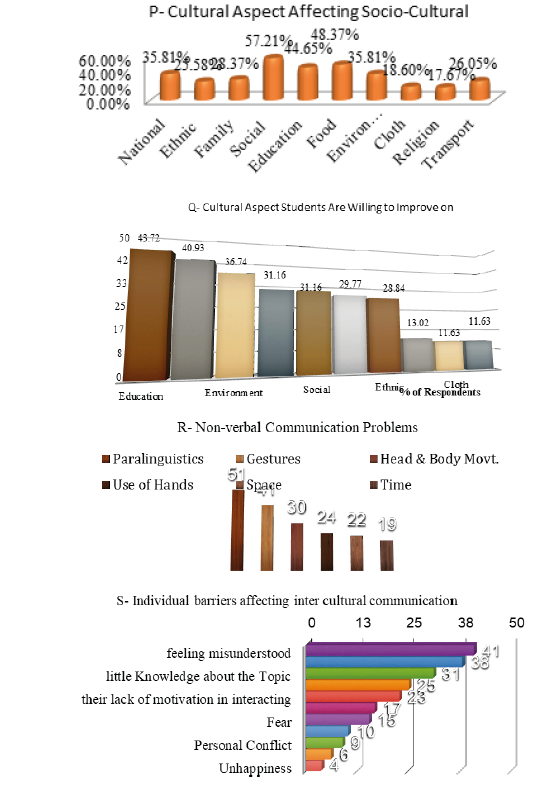
Educational barriers affecting student’s academics: In
Figure 7, students were asked what type of barriers affected them
education wise and were allowed to pick more than one option.
These barriers could be either from the students or teachers
and obstruct smooth teacher-student communication flow. The
barriers listed as a lot to do with their language and Exams. The
result shows that 50.23% comprising of 102 students owed it to
the Language difference, 46.51% owed it to their incorrect Tone,
40.93% comprising of 88 students owed it to their Unfamiliar
Accent, 28.37% comprising of 61 students said it was due to their
low vocabulary buildup, 21.86% comprising of 42 students allege it
was due to their low language proficiency, 20.93% comprising of 45
students indicated it was due to their poor communication skills,
others reasons are graphically represented (Figure 7).
Figure 7:Students educational barriers.

Social barriers affecting inter cultural communication:
This has to do with the social environment factors in china.
Nigerian students were asked what kind of social barriers hindered
their successfully interaction and communication with the Chinese
nationals and were allowed to choose multiple options. 53.02%
comprising of 114 students indicated Racial discrimination to be
a major social barrier, 44.65% comprising of 96 students indicated
a difference in perception & Viewpoint, 26.51% comprising of
57 students chose stereotype, 26.05% comprising of 56 students
indicated misinterpretation of non-verbal actions, 23.26%
comprising of 50 students indicated culture shock, 22.79%
comprising of 49 students owed it to politeness, 8.84% comprising
of 19 students indicated gender was a barrier. This reason
associated with social factors is graphically represented (Figure 8).
Figure 8:Showing socio-cultural barriers.
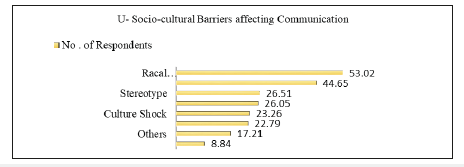
Socio-cultural adaptation
This covers the second part of the questionnaire. Here students
were asked to choose between a 5point scales ranging from not
difficult - A little difficult - Comparatively difficult- Difficult- Very
difficult. It’s clear from the 25 questions, students find “Dealing
with Discrimination (3)” the most difficult, as this had the highest
average score. “Weather in China (2.79)”, was the second most
difficult, while “Seeing things from china point of view (2.73)” came
third. “Dealing with unsatisfactory service (2.71)” was fourth, and
“Dealing with someone who is unpleasant (2.62)” came fifth. Other
adaptation problems are listed in the graph (Figure 9).
Figure 9:Graphical representation of students socio-cultural adaptation.
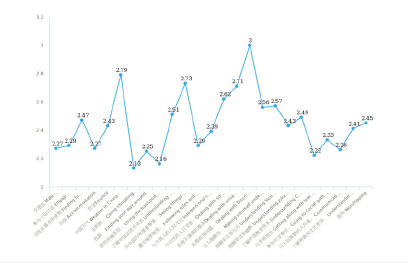
Emotions & feeling
Students were asked how they felt when they encounter
barriers or challenges. It’s glad to see that 52.56% remained
positive and are creatively looking for strategies to deal with the
situation. 33.95% feels the need to give up, 30.95% feel frustrated
and disappointed. Some students feel quite comfortable, while
others feel embarrassed, and depressed. These are well represented
in the Table 1.
Table 1:Nigerian students emotions & feelings.
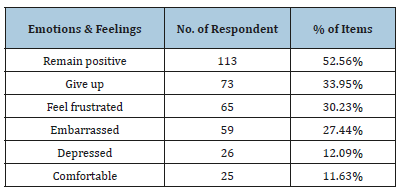
Coping Pattern
Since we know the challenges and barriers these students
face, it’s also important to know how they overcame it. Students
were asked how they cope with misunderstanding and difficulties.
44.19% comprising of 95students said they withdrew in the face of
difficulties, 41.86% comprising of 90 students indicated Avoidance,
22.79% comprising of 49 students had to compromise, 15.81%
comprising of 34 students integrated, 13.02% out of 28 students
had to isolate themselves, 11.16% comprising of 24 students
confronted their difficulties, other coping methods are represented
in the Table 2.
Table 2:Coping methods of Nigerian student.
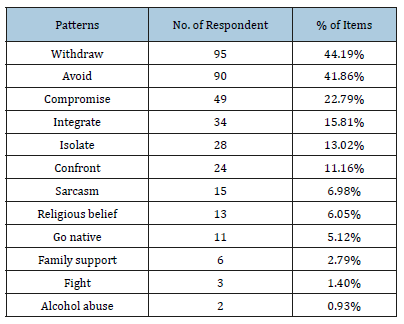
Analysis of Findings
Based on respondent profile
Chart A in Figure 1 shows a higher % of males (60%) to females
(40%). This goes to prove the gender inequality in the educational
aspect that is eminent in Nigeria, while chart B shows that majority
of the Nigerian students in China are youths in their early stage.
Based on language ability & competence
From Chart E in Figure 2 it is observed that majority (73%)
of the Nigerian students do not have Prior Chinese Knowledge
before coming to China. They either learnt or acquired the language
upon entry into China. This could be due to lack of expansion of
the Confucius institute, as there are only 2 recognized Confucius
institute, one in University of Lagos in the West and the other in
Nnamdi Azikiwe University Anambra state in the East with two
branches. This is not enough to serve a growing population of Over
180 million people located in 6 geographical zones. From Chart
D, we can tell the Nigeria students only have a basic knowledge of
the Chinese language as majority have only studied for 1-2 years.
Although the Nigerian students are known to be fast learners when
it comes to learning Chinese, but this does not guarantee cultural
competence.
Age has been argued by many researchers to have a relationship
with language study. Fig 6 confirms that Age currently has no role
in the Nigerian students (Youths) language ability. This could be
because most of them are youths (18-35years) in their early stage
when the brain is active and ready to work. It could also be as a
result of their belief; that the youthful stage is a time to achieve all
one sets his/her mind on. However, 60.47% agreed that ability to
study does diminish with age. This is well understood as a Child
learns and acquires a language easier and faster than an adult.
Chinese language is not only interesting and Unique, but a major
barrier to inter-cultural communication. It’s writing style that has
a long history seems to be an uphill task for 53% majority of the
Nigerian students as indicated in Chart I, while grammar is the major
headache for 26.98%. Their inability to type characters already
limits their social interactions as they cannot send messages, or chat
on the Chinese social networks. Their grammatical incompetence
affects both oral and written ability.
Based on educational, social and cultural and personal
adjustment
It is evident from the above investigations that the Nigerian
Students would love to increase their Chinese educational
Knowledge. Difference in language poses a challenge to the Nigerian
student. They often do not answer questions or actively participate
in class due to problem of accents and language difference, but take
their course works seriously. They try to avoid mispronunciations,
and dramas while in class. While Silence is considered a virtue in the
Chinese Classroom, a highly interactive class, open to discussion,
where students are free to ask questions is prized in the Nigerian
classroom. The Use of Language also causes lack of comprehensive
note taking, and ineffective interaction in class. Some researchers
like Pruitt [20] stated that African students have a problem with the
host country examination format, while Arubayi [21], Okwudishu
[22] states that Nigerian students have a problem with open-ended
questions. This is in contrast with the Nigerian student in China. A
large percentage of the Nigerian students in China seem used to the
Chinese Examination format and grading system, as these ranked
low in Figure 7. Students acknowledge fairness during grading, and
majority didn’t see this as a problem.
Although the Chinese teachers are often times very simple,
casually dressed, and ride on bicycles, yet the Nigerian students
still do not understand the concept behind the informal dressing,
as they do not have an informal relationship with their teacher.
This could be as a result of no personal interest from the teacher,
as a lot of Chinese teachers lack basic information about Nigeria
and Africa as a whole. This perception to an extent affects their
educational adjustment. To facilitate educational adjustment, it is
suggested that teachers know their students, take personal interest
in them and guide them on how to successfully tackle and complete
the course [23]. Socially, the Nigerian students are very friendly, yet
view Racism as their biggest Socio communication difficulty, and
find it extremely difficult dealing with discrimination. Although
they have many Chinese friends, yet the rarely hang out with them.
Their inability to socialize is a clear indication of their outward
expression to unpleasant situation [24-26].
Culturally, both countries are both Communalist, yet their style
of communalism varies to a great extent. The Nigerian students
cultural problems arise as a result of lack of theoretical/classroom
cultural knowledge. There have both physical and culture bound
problems, this range from difference in perception and viewpoint,
misinterpretation of non-verbal cues to adapting to the weather
in China, food, etc [27,28]. The Nigerian students try so much to
overcome these challenges, their outward expression speaks
volume, and their reaction is clearly seen in their different coping
patterns. They remain positive, in the face of challenges looking for
a creative way to deal with their problems [29-32].
Conclusion
The main purpose of this study is to investigate and analyze
the cross-cultural communication problems affecting Nigerian
students in China. The researchers intend to identify the nature
of the communication that exists between Nigerian students and
their intended nationals and the various coping methods used
to overcome the difficulties of communication. The electronic
questionnaires were sent to different Nigerian student groups
through Chinese social media. The researchers used descriptive
research methods and surveys to collect data from students [33].
A well-designed closed questionnaire was distributed to student
groups, and a total of 215 respondents took the time to respond
appropriately. Another goal is to study their behavioral patterns
and coping methods. Nigerian students show positive and negative
coping styles. Their negative coping methods include withdrawal
and avoidance, while positive coping styles include confrontation
and compromise. They also feel creative need to devise strategies
to deal with new and unpleasant situations. Cross-cultural
communication and challenges coexist, although it can be seen
from this study that Nigerian students face social, educational,
personal and cultural difficulties. 72.56% of Nigerian students
said they had problems communicating with Chinese citizens.
This reflects two core issues, cultural adaptability and language
proficiency. Most Nigerian students have problems in adapting to
certain sociocultural aspects, such as dealing with discrimination,
seeing things from a Chinese perspective, and dealing with
unpleasant people. More than half of Nigerian students say Chinese
citizens have a negative perception of them and are subject to racial
discrimination. Such perceptions may stem from their assumptions
about cultural similarity or the misinterpretation of nonverbal
behavior.
The Chinese style of ethnocentrism, stereotypes, lack of
understanding of blacks/Africans could be the reason why the
Nigerian students feel discriminated. Second is the language
problem. Most Nigerian students are Basic Chinese learners, and
71.63% of the Nigerian students in the host country communicate
in English. It is clear from the study that language fluency is
an obstacle because most Nigerian students are Basic and
intermediate learners [34]. This affects their social interaction and
the topics to be discussed. It also affects their active participation in
the classroom, as they seem to perform well in group discussions
and assignments. Their daily use of English language impacts
their friendship model, social and cultural behavior with the
Chinese citizens. Although most Nigerian students blame it on
Chinese discrimination, language barriers cannot be overlooked.
When the problem of language barrier is solved, the problem of
misunderstanding, thinking, ethnocentrism, prejudice, etc. will
be reduced. In the Socio-adaptation aspect, apart from China’s
weather and food, Nigerian students have no difficulty adapting
to China’s environmental conditions; during social interactions, its
noted that they have over six Chinese friends, but they hardly ever
hangout with them.
They have had difficulties in maintaining friendship with
Chinese citizens; their frequency of hangout is at most once in a
month. Also Nigerian students seem to have some unrealistic
expectations for their teachers and administrators in their
communication with schools. Lack of listening seems to be an
obstacle, and they want teachers and administrators to be able to
listen to them. Accents also seem to affect their communication
skills. The changes in education policy are not communicated in
advance, and most of the information is communicated halfway
through the semester, which is a big problem for most scholarship
students. The age, gender or degree of Nigerian students has no
direct impact on their experience and challenges, as they all meet
the same challenges. However, the longer they stay, the better their
adaptation will be. When they encounter difficulties, some students
think it is necessary to develop strategies to deal with this situation,
and show positive behavior, such as Confronting and compromising.
At the same time, some others feel frustrated and disappointed,
opting for withdrawal and avoidance, and they withdraw into their
ethnic enclaves. Positive changes in the face of difficulties will
eventually result in better adaptation and other benefits. These
experiences will help to broaden the horizons of Nigerian students
so that they can accommodate others and provide them with the
skills they need to succeed in the global marketplace.
Acknowledgement
This work was carried out in the overseas college of Xiamen
University Xiamen China. The author gratefully acknowledges the
support of Prof Pan Chao qing and fellow Nigerian students in
China.
References
- Hayes RL, Lin HR (1994) Coming to America: Developing social support
systems for international students. Journal of Multicultural Counseling
& Development 22(1): 7-17.
- Zhai L, Scheer SD (2002) Influence of international study-abroad
programs on agricultural college student. Journal of International
Agricultural and Extension Education 9(3): 23-29.
- Drexler DS, Campbell DF (2011) Student development among
community college participants in study abroad programs. Community
College Journal of Research and Practice 35(8): 608-619.
- Miller EJ (1993) Culture shock: A student’s perspective of study abroad
and the importance of promoting study abroad programs. Paper
presented at the Annual Intercultural and International Communication
Conference pp. 25-27.
- Waco K (2008) Study abroad: Fisheries in a global environment.
Fisheries 33(1): 38-39.
- Spence M (2011) The next convergence: The future of economic growth
in a multispeed world. Farrar, Straus and Giroux, New York, USA.
- Badaracco JL (1991) The knowledge link: How firms compete
through strategic alliances. Harvard Business School Press, Boston,
Massachusetts, USA.
- Klomegah RY (2006) Social factors relating to alienation experienced by
international students in the US. College student journal 40(2):
303-315.
- Lee J, Rice C (2007) Welcome to America: International student
perceptions of discrimination. Higher Education 53(3): 381-409.
- Segal G (1992) China and Africa. The annals of the american academy of
political and social science 519(1): 115-126.
- Alessi C, Hanson S (2012) Expanding China and Africa oil ties. Council of
Foreign Relations.
- Ehizuelen MMO (2019) Education and skills development cooperation.
Frontiers of Education in China 13(4): 553-600.
- Liu H, Li A (2014) Evolution of the chinese policy of funding african
students and an evaluation of its effectiveness, Draft of UNDP Project.
- Wan X (2015) The trend of China’s aid to african education. NORRAG
News, Switzerland. 52: 133-135.
- Hull WF, Klineberg (1979) An international study of adaptation and
coping. Praeger, New York, USA.
- Tugba S (1984) Intercultural communication problems of nigerian
students in the portland metropolitan area: A comparative study of a
review of literature and personal interviews. Dissertations and Theses.
p. 3420.
- Disima (2004) Cultural adaptation of foreign students in China. Nanjing
Normal University, China.
- Oppong CO (2016) Education and intercultural relations: a case study
of Ghanaian and Nigerian students in Finland. University of Eastern
Finland, Europe.
- Anderson A (2003) Women and cultural learning in Costa Rica: Reading
the contexts. Frontiers: The Interdisciplinary Journal of Study Abroad
9: 21-52.
- Pruitt Frances J (1978) The adaptation of African students to american
society. International Journal of Intercultural Relations 2(1): 90-118.
- Eric AA (1981) Perceptions of problems identified by nigerian students
in american higher institutions: A comparative analysis. Personnel
Abstracts, College Student Journal 15(2): 116-120
- Okwudishu, Appolonia U (1983) The Goals, objectives and problems
of nigerian students in certain U.S. Universities, Southern Illinois
University, USA.
- Helen C, Ozawa M (1970) Foreign student in the united states. School of
social work, University of Wisconsin, USA.
- Alexander AO (2011) Cultural faces of interpersonal communication in
china and nigeria. 8: 225-247.
- Richard B (1982) Cross-cultural encounters. Press, New York, USA.
- Brislin R, Yoshida T (1994) Intercultural communication training: An
Introduction. Sage publications, Thousand Oaks, California, USA.
- Brown HD (2007) Principles of language learning and teaching. (5th
edn.), Longman, White Plains, New York, USA.
- Sujuan G (2014) A study on African students in china and their crosscultural
adaptation. Journal of Kaifeng Institute of Education 34(2): 127-
130.
- Gudykunst WB, Kim YY (2003) Communicating with strangers. (2nd
edn), McGraw Hill, Boston, USA.
- Gudykunst WB (2003) Cross-cultural and intercultural communication.
California State University, Fullerton, USA.
- Edward HT (1981) Culture as an irrational force in beyond culture.
Anchor Press/Doubleday, New York, USA.
- Xia L, Lijun X (2014) The influence of Sino-African cultural difference on
the education of African students in China: Taking angola students as the
example. Journal of Chongqing University of Education 27(1): 133-136.
- Jane Marshall (2013) University world News Report.
- Ye Shuai (2011) A comparative analysis of the cross-cultural
communication based on the Somali students and the chinese students
on time and family concepts. Kexue Wenhui 11: 30-31.
For more articles in Journal of archaeological science abbreviation
